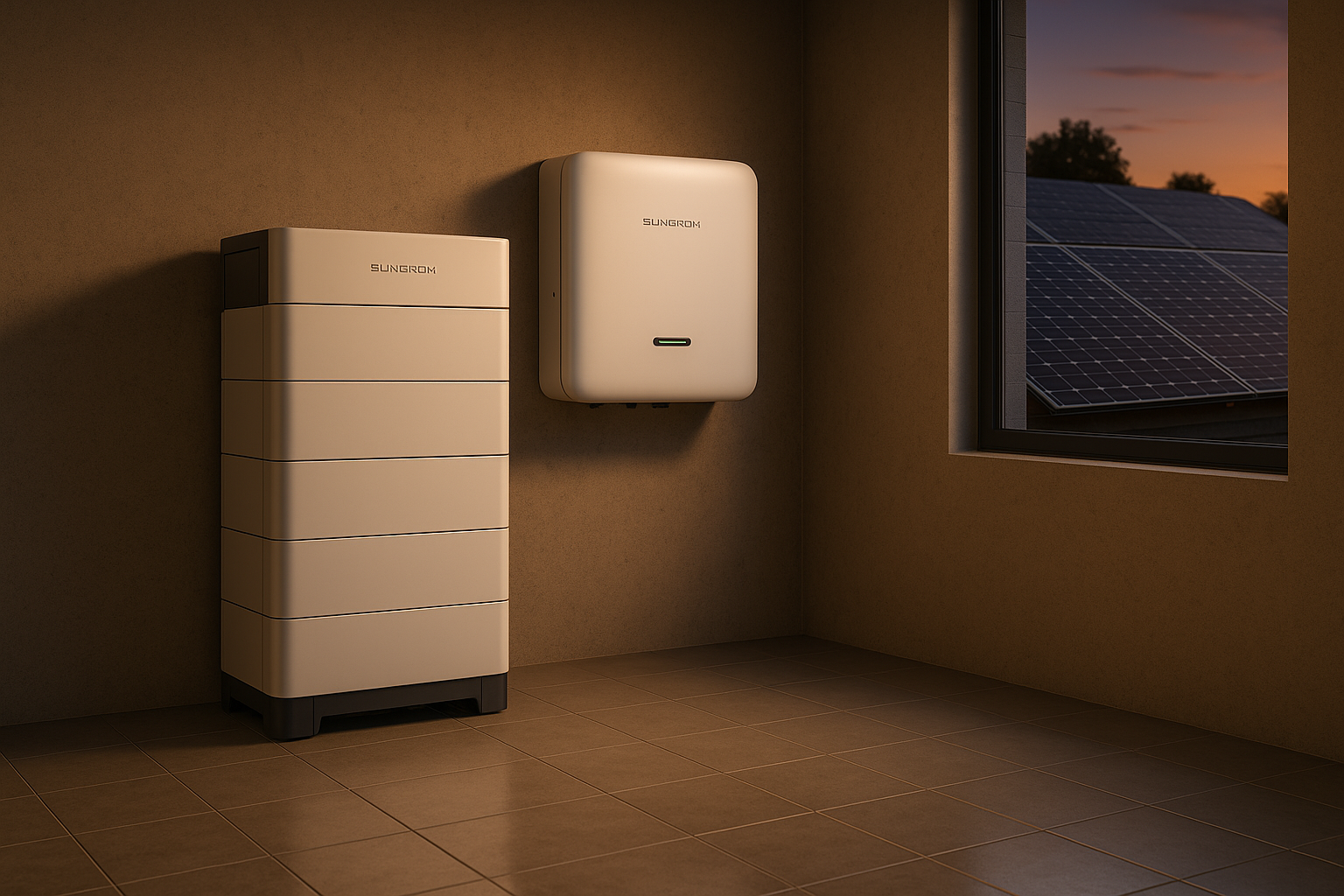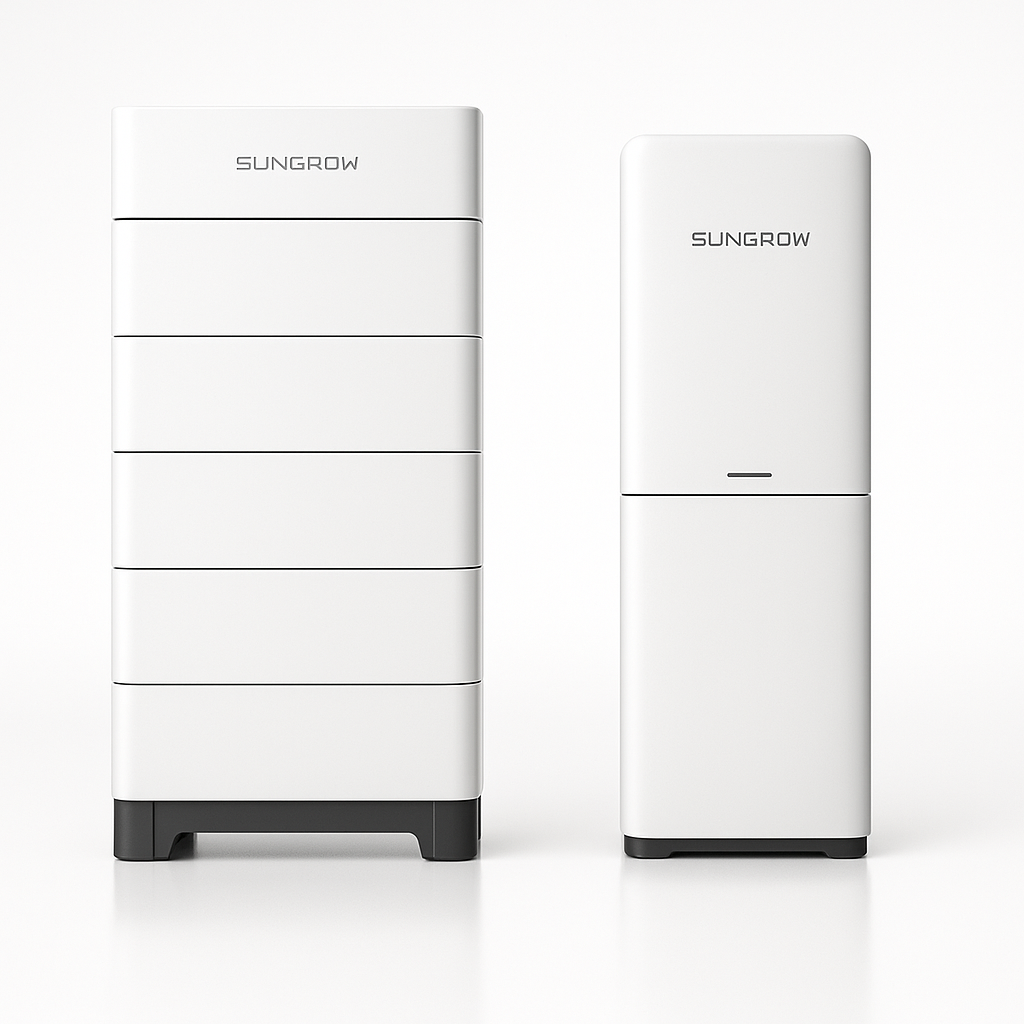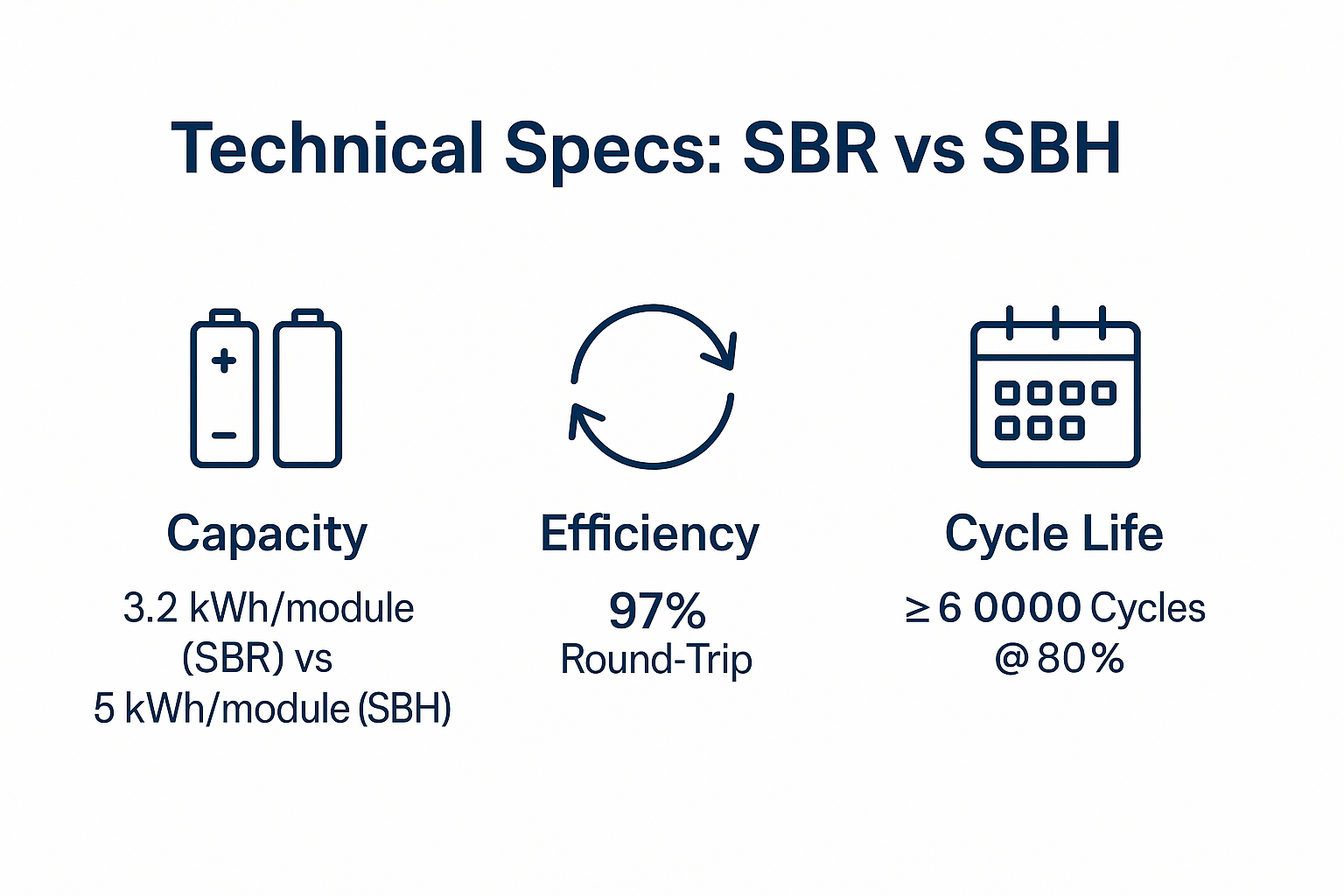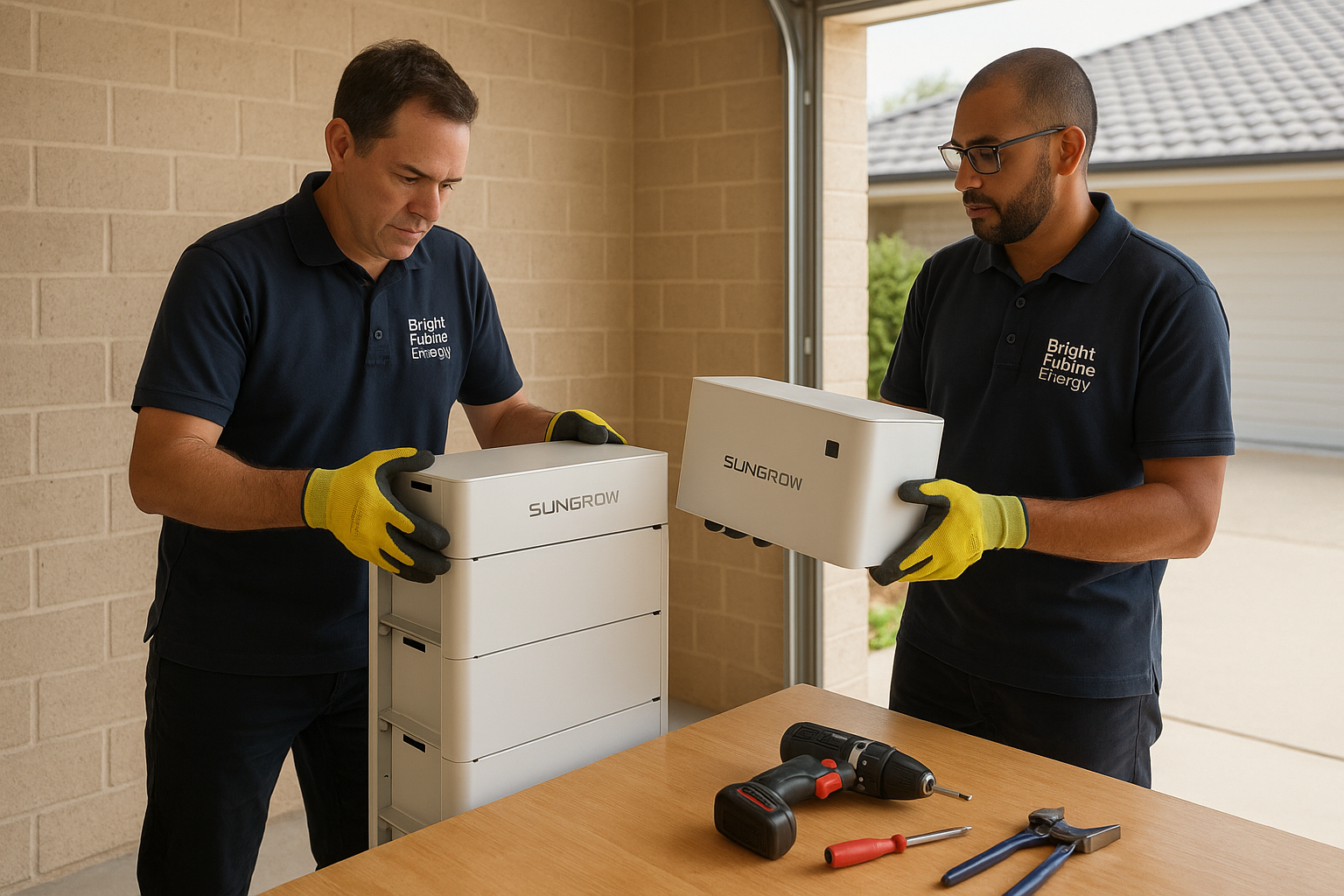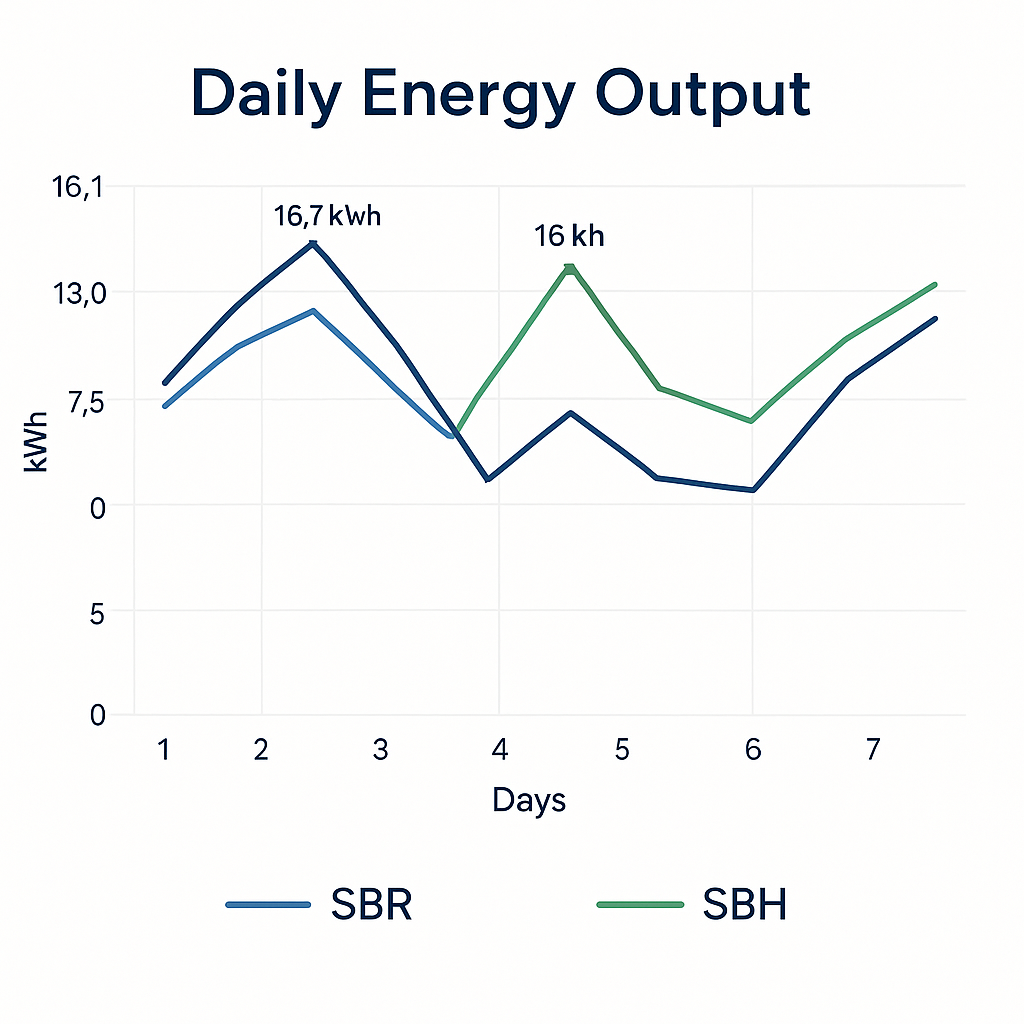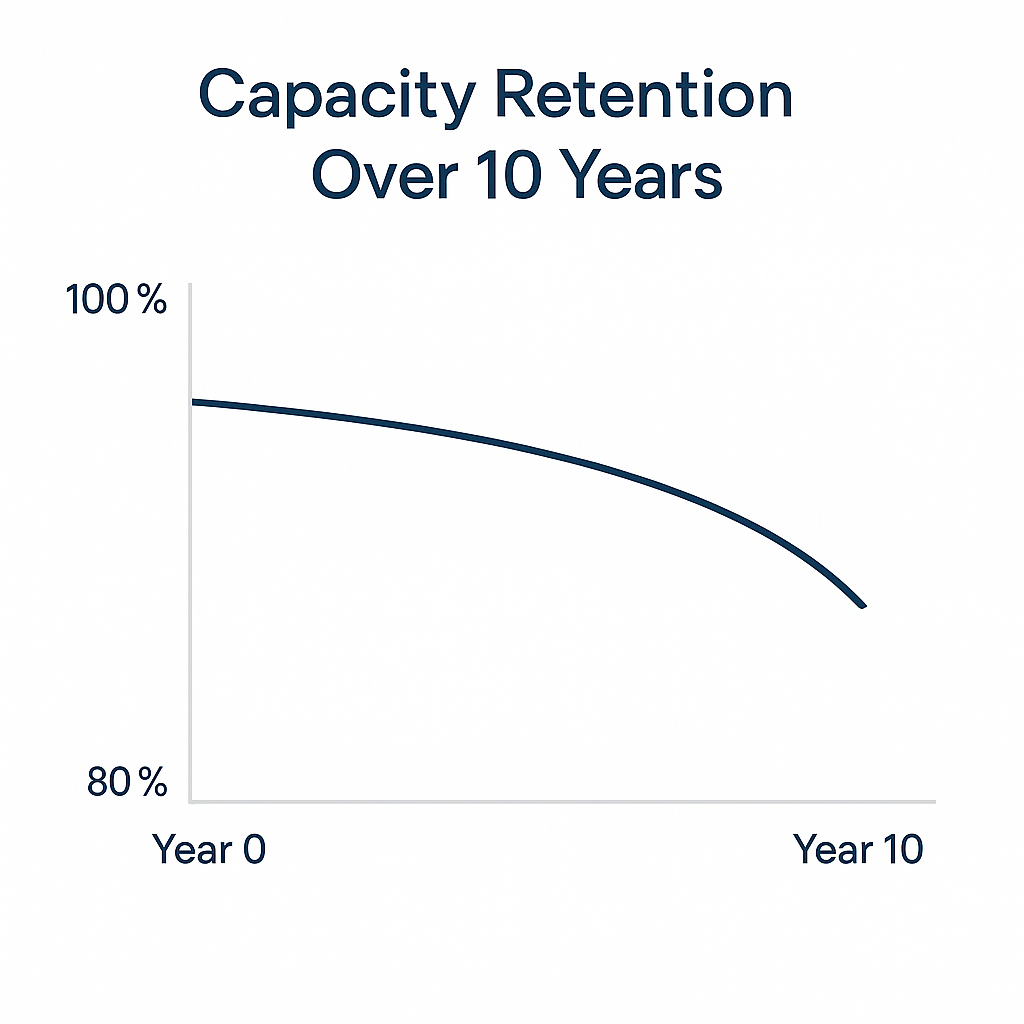Sungrow SBR & SBH series: Affordable, scalable home batteries for 2025
Sydney’s energy landscape is changing fast. Recent summers have strained the grid with heatwave-driven demand and even prompted blackout warnings for NSW (ABC News, 2024). At the same time, households in suburbs from Marrickville to Randwick are facing rising electricity bills – with power costs set to jump about $150 a year for many Sydney customers (ABC News, 2025). In this climate of instability and high prices, solar battery storage is becoming a must-have for future-savvy homeowners.
Enter Sungrow’s SBR and SBH series home batteries – two flexible solutions to keep your lights on and bills down. The Sungrow SBR is a modular rack-style battery that can grow to massive capacities (up to ~150 kWh) and is built tough for outdoor installations.
The Sungrow SBH is a sleek wall-mounted battery system using 5 kWh modules (usually installed as 5–10 kWh units) that fits neatly in garages or tight spaces. Both promises to store solar energy, provide backup power, and shield you from peak rates. Which battery suits your home’s needs best? Let’s dive in and find out.
Overview of Sungrow SBR and SBH series
Sungrow is a global leader in renewable energy technology with over 28 years in the industry (Wikipedia, 2025). The company manufactures solar inverters and battery systems used around the world, known for innovation and reliability. In fact, Sungrow is one of the top suppliers of residential batteries in Australia’s market (Clean Energy Council, 2025). With the SBR and SBH series, Sungrow offers Aussie homes a choice between two high-performance storage options:
- SBR Series: A stacked battery rack system. The SBR uses modular 3.2 kWh lithium battery modules stacked in a floor-standing rack. You can start with a small setup (around 9.6 kWh usable from 3 modules) and expand up to 100+ kWh by adding more modules and racks over time (Clean Energy Reviews, 2024).
- This makes SBR ideal for larger homes or small businesses that might scale up. The robust cabinet is outdoor-rated (IP55 weather protection) so it can sit outside or in a garage (VP Solar, 2025).
- SBH Series: A slim battery for homes, designed as a compact tower or wall-mounted unit. The SBH uses larger 5 kWh battery modules and stacks 2–8 modules for 10–40 kWh per battery tower (Clean Energy Reviews, 2024). For even more storage, up to four SBH towers can link in parallel (160 kWh total), though a single tower is plenty for most households (Sungrow, 2025).
- The SBH’s sleek form factor and wall-attachment bracket allow installation in tight spaces – perfect for inner-city homes or apartments with limited floor area. It’s rated for indoor or outdoor use (IP65 weatherproof design) and operates quietly, blending into a home environment.
In short, SBR is like a Lego-style battery bank – stack modules to build a huge capacity, with a utilitarian look. SBH is the elegant alternative, a minimalist battery appliance you can mount on the wall. Both use the same proven battery chemistry and tech under the hood, which we’ll explore next.
High-level technical features
Both Sungrow SBR and SBH series boast impressive technical specs for performance and longevity. Table 1 below highlights some key features of each:
|
Feature |
Sungrow SBR Series |
Sungrow SBH Series |
|
Usable capacity range |
9.6 kWh – ~102 kWh per system (expandable) |
20 kWh – 160 kWh per system (expandable) |
|
Module size |
3.2 kWh per module (stack up to 8) |
5.0 kWh per module (stack up to 8) |
|
Round-trip efficiency |
~97% (high efficiency DC-coupled) (SolarCalculator, 2025) |
~97% (high efficiency DC-coupled) (SolarCalculator, 2025) |
|
Cycle life |
≥6,000 cycles @80% capacity (typical) (Clean Energy Council, 2025) |
≥6,000 cycles @80% capacity (typical) (Clean Energy Council, 2025) |
|
Depth of discharge |
100% usable (no reserve needed) |
100% usable (no reserve needed) |
|
Continuous power |
~6–15 kW (depending on modules) |
~10–40 kW (depending on modules) |
|
IP weather rating |
IP55 (Outdoor-ready enclosure) |
IP65 (Fully weatherproof design) (Sungrow, 2025) |
|
Warranty |
10 years (≥80% capacity retention) |
10 years (≥80% capacity retention) |
(Table 1: Comparison of key specifications – Sungrow SBR vs SBH series home batteries.)
Both series use advanced Lithium Iron Phosphate (LFP) battery chemistry – widely regarded as one of the safest and longest-lasting lithium types. LFP batteries run much cooler and are far more resistant to overheating or fire than older NMC lithium batteries, thanks to the stable iron-phosphate cathode (Clean Energy Reviews, 2024).
This means peace of mind and a longer lifespan. Manufacturers commonly rate these batteries for well over 6,000 charge-discharge cycles (roughly 15+ years of daily use) before dropping to 80% of original capacity. In Australia, the Clean Energy Council requires home batteries to meet strict safety standards (CEC Battery Assurance Program) including IEC 62619 certification for LFP cells (Clean Energy Council, 2025).
Both the SBR and SBH are CEC-approved products, built with multi-layer protection, intelligent Battery Management Systems (BMS), and compliance with AS/NZS 5139 installation standards.
Another highlight is efficiency: Sungrow’s high-voltage design and inverter synergy achieve round-trip efficiency around 96–97%, meaning very little energy is lost storing and retrieving your power (Penrith Solar Centre, 2025). Both batteries also offer 100% depth of discharge, so you can use the full rated kWh each day without holding back a reserve (unlike some older batteries).
Overall, on paper the SBR and SBH deliver top-tier performance rivalling well-known competitors like the Tesla Powerwall – but often at a significantly lower cost per kWh.
Modular scalability & installation flexibility
One size does not fit all when it comes to home energy storage. This is where Sungrow’s two battery formats really shine, offering flexibility in both scale and installation:
- Expandable rack (SBR): The SBR series is built for modular scalability. Need more storage? Just add another 3.2 kWh module to the stack (it’s a plug-and-play slide-in). Each SBR battery stack can hold up to 8 modules (~25.6 kWh), and up to 4 stacks can be wired in parallel for ~100 kWh or more total.
- This Lego-like expandability makes SBR perfect for growing families or small businesses. You might start with, say, a 9.6 kWh (3 module) system and later expand to 19.2 kWh (6 modules) if you buy an EV or add air conditioning. The rack design also allows higher power output as you add modules – max discharge climbs from 6 kW (with 3 modules) up to 15–17 kW with a full stack, enough for heavy loads.
- Installation is typically floor-mounted on a sturdy base, either in your garage, an outdoor slab, or a utility room. Example: A Rosebery duplex with a large solar system opted for an SBR with 8 modules (25.6 kWh) initially, then added a second rack in parallel a year later – boosting total storage to over 50 kWh to also support a home office and two EVs.
- Sleek Wall-Mount (SBH): The SBH series is designed for easy installation and space efficiency. Its vertical tower can be affixed to a wall (using a bracket for safety) or stood on the floor, taking up minimal footprint. The wiring and BMS are integrated into the top of the unit, and the battery modules simply stack underneath with no external cabling between modules (Sungrow calls it “plug and play” stacking).
- For homes with moderate storage needs, an SBH might use 2 modules (≈10 kWh) or 3 modules (≈15 kWh) in one slim tower. The ability to install it outdoors or on an apartment balcony is a plus for those without a garage. For example, a Kensington townhouse with limited space installed two SBH 5 kWh modules in a narrow laundry area, yielding around 10–12 kWh of storage – enough to cover their evening usage and fit seamlessly against the wall.
- Neat and unobtrusive, the SBH looks like a modern appliance. And if the homeowner ever needs more capacity, they can stack an extra module or even add a second tower (with a combiner box) up to a total of 80 kWh. The SBH is truly a “set and forget” solution – once mounted, it quietly does its job without eating into your living area.
Whether you have a sprawling home in Turramurra with high energy needs or a compact terrace in Redfern, Sungrow’s range can be configured to suit. The scalability of SBR means you won’t outgrow your battery; it grows with you. Meanwhile, the flexibility of SBH means even apartment-dwellers can enjoy solar storage on a smaller scale.
Both types integrate with Sungrow’s hybrid inverters for a tidy setup, and professional installers (like Bright Future Energy’s team) can advise on the best mounting location and configuration. It’s all about tailoring the solution to your home.
Performance &real-world yield
Paper specs are great, but how do these batteries perform in real Sydney conditions? The answer: reliably and efficiently, even during our harsh summers. Key performance aspects include:
- High efficiency & yield:Both SBR and SBH have round-trip efficiency around 95–97%, meaning very little energy is wasted charging or discharging the battery (SolarQuotes, 2025). In real-world use, you might lose only 0.1 kWh out of every 5-kWh stored; a negligible drop. This high efficiency is partly due to the high-voltage design that pairs with Sungrow’s inverters, minimizing conversion losses.
- It means more of your solar energy is actually stored for later use. Over a year, a 10-kWh battery could deliver about 9.5–9.7 kWh for every 10 kWh it captures, saving you more on bills (Penrith Solar Centre, 2025).
- Temperature resilience: Sydney summers regularly hit 35–40 °C, which can impact battery performance. Fortunately, LFP chemistry is known for stable operation in high temperatures – typically up to 50–60 °C ambient (CSIRO, 2021). Both Sungrow series are engineered with battery management systems that monitor temperature of each module.
- During the February heatwave last year, for instance, a Bright Future Energy client in Parramatta observed their SBR battery still outputting at full power even as the garage hit 38 °C. The system will intelligently derate (reduce power) if cells get too warm, protecting the battery. CSIRO recommends avoiding sustained extremes (CSIRO, 2021), but occasional hot days won’t faze these batteries.
- The SBH’s IP65 enclosure is also sealed against dust and heat, and the SBR’s passive thermal design allows air flow between modules. In short, both are built for Australian conditions – from winter nights to summer scorchers.
- Daily cycling &yield: Most Sydney homes with solar will cycle their battery every day – charging up with excess solar by afternoon, then discharging to power the home overnight. Homeowners consistently report strong performance from Sungrow units in this daily cycle use.
- For example, a Coogee household with a 15 kWh SBR (five modules) uses it to charge their EV overnight. Each day, surplus solar (that would otherwise go to the grid for a low feed-in tariff) charges the SBR to full by 3 pm. Then from 3 pm onward, as solar production tapers and evening peak rates hit, the battery supplies the home’s needs and even tops up their electric car after midnight.
- By morning, the battery might be at 10% – ready to soak up the next day’s sun. This cycle has dramatically cut their grid imports during peak time (to near zero most days), saving them $600 in a quarter and effectively providing “free” EV fuel from the sun. The SBR’s reliable throughput (over 90% usable each cycle) means the family can count on about 13–14 kWh of actual usable energy daily from their 15-kWh system, even allowing for efficiency losses.
- Grid support: Importantly, using batteries this way has broader benefits. The Australian Energy Market Operator (AEMO) notes that widespread use of home batteries and virtual power plants can significantly reduce peak demand on the grid (AEMO, 2023). In practice, when thousands of batteries discharge during the 6–8 pm peak, it shaves the spike off NSW’s demand curve, easing stress on the network and even preventing blackouts (NSW Government, 2025).
- Your Sungrow battery not only helps your household – it’s also an energy team player for the community. Several Bright Future Energy clients are enrolled in VPP programs where Ausgrid or an energy retailer can discharge a bit of their battery during critical peaks (with the owner’s permission and in exchange for credits). Thanks to fast response times, the SBR and SBH can kick in almost instantly when the grid needs support, delivering power back to the grid within milliseconds.
Overall, real users in Sydney are finding Sungrow batteries live up to the specs. High efficiency, smart thermal management, and robust daily cycling add up to excellent real-world yield – meaning you get the savings and backup power you expect. And the more the grid gets challenged (like extreme heat days or evenings when everyone turns on the aircon), the more valuable your home battery becomes.
Cost, incentives & ROI
Let’s talk dollars and cents. How much do these batteries cost, and what rebates can you get? The good news for 2025 is that home batteries are more affordable than ever in Australia, thanks to tech improvements and new government incentives.
Ballpark figures for an installed Sungrow system are: around A$10,000 (ex GST) for a 20 kWh SBR rack, and roughly A$6,000 for a $1,000+ per kWh). Actual prices vary with the number of modules, inverter inclusion, and installation specifics.
For instance, an 8-module SBR (25.6 kWh usable) with a Sungrow hybrid inverter might be quoted around $15k total, whereas a smaller 5 kWh SBH retrofit on an existing solar system could be as low as $5–6k installed. These upfront costs have been steadily dropping as Sungrow achieves economies of scale (the company manufactures at large scale in Asia). Importantly, 2025 brings significant new subsidies that reduce out-of-pocket cost:
- Federal Battery Rebate (STCs): From 1 July 2025, the Australian Government’s Cheaper Home Batteries Program is providing roughly a 30% upfront discount on eligible home battery installations (Australian Government, 2025). This works through the existing Small-scale Renewable Energy Scheme (SRES) via new STCs (small-scale technology certificates) for batteries.
- In practice, your installer will handle the paperwork and give you an immediate discount off the price, similar to how solar panel rebates are applied (Clean Energy Regulator, 2025). The rebate is capped at 50 kWh of battery capacity (so systems up to 50 kWh get full benefit). For example, on a 10-kWh battery, a 30% rebate saves you about $2,000 – bringing that $6k SBH down to ~$4k net. This is a game-changer for battery ROI.
- NSW state incentives: The NSW government is also encouraging batteries. As of 2025, qualifying homes can get an extra $1,000–1,500 rebate for connecting their battery to a Virtual Power Plant (VPP) (NSW Government, 2025). This is part of the Peak Demand Reduction Scheme. Essentially, if you allow your battery to support the grid at peak times, the state will pay you an upfront bonus.
- For a typical ~10 kWh system, the total support from federal + state can be nearly $5,000 (NSW Government, 2025) – slashing the net cost by about half. Additionally, special programs exist for certain demographics (e.g., the NSW Solar for Apartment Residents (SoAR) Grant offers up to 50% off battery systems in apartment buildings). While the SoAR is a niche scheme, it’s worth exploring if you live in a strata situation in Sydney.
- Other incentives: Households may also be eligible for interest-free loans (e.g., through the NSW Empowering Homes pilot or certain council programs). And of course, if you package a battery with a new solar installation, the whole system benefits from GST credits and STCs on the solar portion as well, improving the overall payback.
- Return on Investment (ROI): With the above incentives, many homeowners are seeing much faster payback times on batteries. A few years ago, a $10k battery might take 10–12 years to pay off in bill savings. Now, with maybe $3k of rebates, that same system only costs $7k, and with high electricity prices it might save ~$1k per year on bills – implying a 7-year payback.
- Actual ROI depends on your usage pattern and tariff: if you have Time-of-Use rates (common in Sydney), batteries shine by charging on solar or off-peak and displacing expensive evening peak power (often 30–40 cents/kWh). For example, if you consume 10 kWh each evening from your battery instead of the grid at $0.30/kWh, you save $3/day, ~$1,095/year.
- Add in savings from avoiding solar export wastage and potential VPP income, and you can see why some systems pay off in under 6–8 years now. Even on flat tariffs, a battery increases your solar self-consumption dramatically – often from 30% to 70–90% – which still translates to big reductions in import energy. And beyond pure financial ROI, many customers value the intangible benefits like blackout protection and energy independence (more on that next).
- One more tip:Businesses can claim accelerated depreciation on storage and possibly get extra incentives (check the Instant Asset Write-off rules). For a Sydney small business installing a 30 kWh SBR for peak shaving, the combination of federal rebate and tax benefits can yield a payback under 5 years – after which the battery provides essentially free buffering of peak demand charges.
Reliability & Warranty
When investing in a home battery, long-term reliability is paramount. Fortunately, Sungrow’s products are backed by solid warranties and a track record of dependable operation.
- Warranty coverage: Both the SBR and SBH series come with a 10-year manufacturer’s warranty, which is now the industry standard for home batteries. This warranty guarantees the battery will retain at least 70–80% of its original capacity after 10 years or a set number of cycles (usually around 6,000–8,000 cycles) – whichever comes first.
- In practical terms, that means if you buy a 20-kWh system, Sungrow assures you’ll have at least ~16 kWh usable in year 10 (Clean Energy Council, 2025). Many users find their batteries actually outperform the warranty; LFP chemistry degrades slowly, especially when not pushed to extreme temperatures.
- For example, a Bright Future client in Rosebery has an early-model Sungrow SBR system installed in 2020 that has already logged about 1,000 cycles. After 5 years, tests show its capacity is still ~95% of new – well on track to easily meet the 10-year guarantee.
- Robust build &safety: Sungrow batteries are built with multiple layers of protection. Each module has voltage and thermal sensors, and the Battery Management System will isolate any module if a fault is detected. The units have an inbuilt DC isolator/circuit breaker for safety (Clean Energy Reviews, 2024), which immediately disconnects the battery during faults or maintenance.
- Both SBR and SBH enclosures are weatherproof (IP55/IP65) and made of durable materials to handle Australian sun and rain without corrosion. They’re also engineered to withstand knocks; important in a garage environment.
- The SBR’s cabinet, for instance, is powder-coated steel with a lockable access panel, and the SBH’s module casing is a high-impact resistant polymer. Neither battery uses cobalt in its cells, eliminating a potential fire risk and avoiding toxic materials (Clean Energy Reviews, 2024).
- Thermal management: While the batteries don’t have active cooling fans (which adds noise and points of failure), their passive thermal design and BMS logic keep them operating safely. If the internal temperature ever approaches unsafe levels (unlikely unless external temps are >50 °C), the system will throttle charge/discharge power or shut off to protect itself (CSIRO, 2021).
- This built-in self-preservation means you can trust the battery to manage heat and prevent over-stress. Real-world data from Sungrow’s fleet in Australia (including many units in hot Northern Territory climates) show excellent reliability with essentially zero thermal incidents reported.
- Endurance in the field: Sungrow’s confidence comes from extensive testing – these batteries undergo thousands of cycles in the lab, environmental chamber testing (for humidity, salt mist, etc.), and compliance testing with international standards (IEC 62619, UN38.3 transport safety, etc.).
- The SBR series has now been in Aussie homes since 2021, with very low failure rates reported. Should any issue arise, Sungrow has local support centres and the warranty includes repair or replacement of defective units.
- It’s also worth noting that Sungrow is a financially strong company (publicly listed in China) with over 740 GW of products deployed globally (Wikipedia, 2025) – so you can have confidence they’ll be around to honour warranties in 2030 and beyond.
In short, both batteries are designed for a 10+ year life in tough conditions. Regular firmware updates (delivered via the Sungrow monitoring app) continue to optimize performance and longevity.
And for added peace of mind, Bright Future Energy provides an installation warranty on workmanship and will handle any warranty claims on your behalf. We’ve installed dozens of Sungrow batteries around Sydney with excellent feedback; homeowners love that these units just quietly do their job year after year, with minimal attention needed.
Local Installation & After-Sales Support
Choosing a quality battery is only half the story – you also need quality installation and support. That’s where Bright Future Energy comes in. We are a Clean Energy Council accredited installer for battery storage and solar, serving Sydney and NSW with end-to-end project management. Here’s what to expect when you install a Sungrow SBR or SBH with us:
- Expert site assessment: Every home is different. Our team will evaluate your property (either through a free on-site or virtual consultation) to determine the optimal battery placement, size, and integration with your existing solar. We consider ventilation, wall structure for mounting, shading, and distance to your switchboard.
- Safety is paramount – we follow AS/NZS 5139 standards to the letter, which dictate clearances, enclosure requirements, and other installation safety measures for batteries (Clean Energy Council, 2021). For example, AS/NZS 5139 requires batteries to be isolated from habitable rooms or installed in protective enclosures – we’ll ensure compliance while keeping things practical.
- CEC-Accredited installers: Your battery will be installed by our highly trained electricians who hold the Clean Energy Council’s Battery Storage Endorsement. This means they’ve undergone specialist training on safe battery wiring, energy management system setup, and emergency procedures.
- We never subcontract random sparkies – our in-house crew has 15+ years of combined experience with systems like Sungrow, Tesla, and others. They will handle everything from mounting the unit securely (using the manufacturer’s brackets and seismic anchoring if required) to configuring the Sungrow hybrid inverter for battery operation. We take care of all electrical and structural certifications, and we’ll even assist with your network provider’s paperwork if you’re joining a Virtual Power Plant program.
- Seamless integration: If you also need solar panels or an EV charger, we can coordinate the installation so that all components work in harmony. Bright Future Energy specializes in integrated solar-battery-EV solutions – for instance, we can set up your Sungrow battery to charge your electric vehicle via a smart charger overnight using stored solar, effectively giving you $0 “fuel” cost. (Check out our guide to EV charging and battery storage on our EV & Solar Battery Storage page for more info.)
- We ensure your system’s communication – between the inverter, battery, and any smart apps – is rock solid. With Sungrow, this typically involves the iSolarCloud platform, which we’ll configure on your phone/PC so you can monitor your energy flow in real time.
- After-sales support: Our commitment doesn’t end after installation. We provide a comprehensive handover, including training you on the system dashboard and explaining how to operate in backup mode during a blackout. All Sungrow batteries installed by Bright Future Energy come with ongoing local support – if you have any questions or if the system raises an alert, you can call us and speak to a Sydney-based technician.
- We also offer annual system check-ups on request, where we’ll inspect your battery health, perform any firmware updates, and test backup functionality. And in the unlikely event of a fault, we’ll coordinate directly with Sungrow for warranty service, including handling shipping or on-site repairs. Essentially, we’ve got you covered so you can enjoy your solar battery worry-free.
- Compliance and safety: Bright Future Energy takes all necessary precautions during and after install. This includes providing appropriate signage (as required by standards) to identify the site has a battery energy storage system, installing isolation switches and protection devices according to the electrical code, and lodging a compliance certificate with NSW authorities.
- We also register your system with the manufacturer to ensure warranty traceability. By choosing accredited installers, you eliminate the risks of improper setup – which could otherwise affect performance or insurance. We pride ourselves on tidy installs that not only work great but look great (no ugly conduit runs or loose cables).
In summary, going with Bright Future Energy for your Sungrow battery means a smooth experience: quality components, installed by experts, backed by local service. We’ve put batteries into homes in Alexandria, Coogee, Marrickville, Randwick, Zetland and beyond – chances are, we’ve worked on a roof or garage just like yours.
Check out our gallery and testimonials to see how we’ve helped fellow Sydneysiders achieve energy independence. We’re here to support you on your journey from the first quote to years after the install.
Future trends &integration
Home batteries are not just a static addition – they’re part of a smarter, evolving energy ecosystem. By choosing a Sungrow SBR or SBH, you’re setting yourself up to participate in future innovations, such as:
- Virtual Power Plants (VPPs): We touched on this earlier – a Virtual Power Plant is essentially a network of home batteries aggregated via software to act like a big power plant (Wikipedia, 2025). Both Sungrow series are fully compatible with VPP programs run by various energy companies. In the coming years, VPPs are expected to become mainstream in Australia, as they help stabilize the grid and reward consumers.
- With a Sungrow battery, you can opt into a VPP via your retailer’s app or a third-party aggregator. Your battery would then automatically discharge small amounts during peak events in return for credits or payments. It’s a great way to earn extra income from an asset sitting in your garage. As VPP incentives grow, your ROI only improves.
- Plus, you get the satisfaction of contributing to a more reliable grid. The Sungrow systems include remote communications and can receive dispatch signals, so joining a VPP is usually a simple software onboarding – no hardware changes needed.
- EV Integration (V2H/V2G): The line between home batteries and electric vehicles is blurring. In the near future, EVs will increasingly act as batteries on wheels, and technologies like vehicle-to-home (V2H) or vehicle-to-grid (V2G) will allow EVs and stationary batteries to work together. Sungrow’s hybrid inverters are ready for this – they support AC coupling with EV charging systems.
- For example, you could have a scenario where your SBR battery and your EV together form a larger energy pool that powers your home or feeds the grid. When your car is at home and plugged into a bidirectional charger, the inverter’s energy management system could prioritize using the car’s battery once your home battery is depleted.
- This essentially expands your effective storage. While V2G standards are still evolving (and require compatible cars like the Nissan Leaf or certain new EVs), installing a Sungrow battery now means your home is future-proofed for this trend. You’ll be ready to tap into your car’s huge battery to further reduce grid reliance or sell power during price spikes.
- Smart home energy management: Sungrow provides the iSolarCloud platform which already gives you smart controls (like time-based charging, setting reserve levels, etc.). But the future is headed towards deeper home integration. Picture your battery working in tandem with smart appliances, home automation systems (like Alexa or Google Home), and even weather forecasts.
- For instance, if a hot day is forecast, the system could automatically pre-charge your battery in the morning to full, anticipating an aircon spike and potential grid strain. Or if your electricity plan has a demand charge, a smart algorithm could ensure the battery output caps your grid draw below a threshold to avoid extra fees. Integration with home automation platforms is growing – APIs and services are emerging that can tie the Sungrow battery data into smart home hubs.
- This means more user-friendly control and optimization. Additionally, new third-party apps and services (often powered by AI) are being developed that can sit on top of your battery system to maximize savings – by learning your usage patterns, solar forecasts, and tariff details. The modular nature of Sungrow’s system means it’s likely to be compatible with these innovations, either through firmware updates or add-on controllers.
- Grid services and market trading:Looking further ahead, homeowners may even be able to participate directly in energy markets. There is talk of creating frameworks where home batteries can trade energy or provide ancillary services (like frequency control) for the grid. Trials are already underway in Australia with some battery owners being paid for such services.
- Sungrow batteries, with their fast response and standard compliance, are good candidates for these programs. They can react in sub-seconds to grid signals, meaning your home battery could one day get paid to help balance frequency or voltage – all autonomously. Keep an eye on initiatives by AEMO and energy regulators that could unlock new revenue streams for battery owners.
- Essentially, a home battery might evolve from a passive device into an active micro-asset in the energy market. By installing one now, you position yourself to capitalize on these future opportunities as they become available.
- The overarching trend is clear: batteries are becoming central to the modern energy system. They enable greater renewable adoption, empower consumers, and enhance grid stability. With Sungrow’s systems, you’re not buying a static box – you’re investing in a dynamic piece of technology that will integrate with your home life and the broader grid in increasingly sophisticated ways over the next decade.
Bright Future Energy stays updated on all these developments, so we’ll be here to help you upgrade or adjust your setup to tap into new benefits as they arise.
Final thoughts
In conclusion, Sungrow’s SBR and SBH series batteries offer Sydney homeowners two fantastic pathways to energy independence. If you need large-scale storage or plan to expand over time – the SBR’s modular rack system provides virtually unlimited scalability in a rugged outdoor-ready package.
If you prefer a streamlined, compact solution for typical home needs – the SBH’s slim wall-mount design delivers 5–15 kWh of reliable storage with minimal fuss. Both leverage Sungrow’s expertise in safe LFP battery tech, both come with 10-year warranties and strong performance track records, and both can slash your power bills while keeping your lights on during outages. It really comes down to your capacity needs and space available: go SBR for maximum power, SBH for maximum convenience.
2025 is the perfect time to make this investment. With new government rebates, you can save thousands on a battery install and enjoy a payback well within the warranty period. More importantly, you’ll be protecting yourself from rising energy costs and grid disruptions – essentially future-proofing your home. Imagine gliding through the next blackout comfortably, or seeing near-$0 energy bills because your solar and Sungrow battery cover almost all your needs. That’s the bright future we want for all our clients.
Ready to take the next step?
Bright Future Energy is here to help you make it happen. Explore our Sungrow battery solutions – book your free consultation today. We’ll assess your usage and recommend the ideal setup (we’re brand-agnostic too, so if a different battery suits you better, we’ll tell you). Our goal is to maximise your savings and energy resilience. Join the growing number of Sydney homeowners seizing control of their power future with solar batteries.
Get in touch with our friendly team, and let’s start your journey toward lower bills and a cleaner, more reliable energy lifestyle. Here’s to powering your home with sunshine; day and night!
Your content goes here. Edit or remove this text inline or in the module Content settings. You can also style every aspect of this content in the module Design settings and even apply custom CSS to this text in the module Advanced settings.
Your content goes here. Edit or remove this text inline or in the module Content settings. You can also style every aspect of this content in the module Design settings and even apply custom CSS to this text in the module Advanced settings.
Your content goes here. Edit or remove this text inline or in the module Content settings. You can also style every aspect of this content in the module Design settings and even apply custom CSS to this text in the module Advanced settings.
